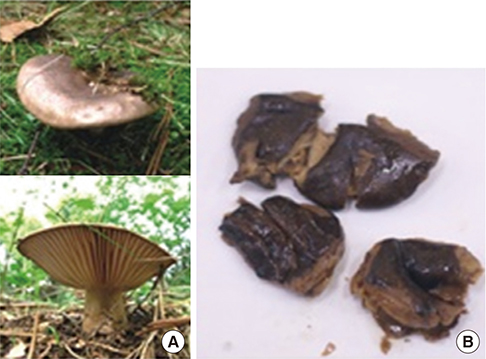J Korean Med Sci.
2016 Jul;31(7):1164-1167. 10.3346/jkms.2016.31.7.1164.
A Case of Mushroom Poisoning with Russula subnigricans: Development of Rhabdomyolysis, Acute Kidney Injury, Cardiogenic Shock, and Death
- Affiliations
-
- 1Department of Internal Medicine, College of Medicine, Dankook University, Cheonan, Korea. jtcho@dankook.ac.kr
- KMID: 2373739
- DOI: http://doi.org/10.3346/jkms.2016.31.7.1164
Abstract
- Mushroom exposures are increasing worldwide. The incidence and fatality of mushroom poisoning are reported to be increasing. Several new syndromes in mushroom poisoning have been described. Rhabdomyolytic mushroom poisoning is one of new syndromes. Russula subnigricans mushroom can cause delayed-onset rhabdomyolysis with acute kidney injury in the severely poisoned patient. There are few reports on the toxicity of R. subnigricans. This report represents the first record of R. subnigricans poisoning with rhabdomyolysis in Korea, describing a 51-year-old man who suffered from rhabdomyolysis, acute kidney injury, severe hypocalcemia, respiratory failure, ventricular tachycardia, cardiogenic shock, and death. Mushroom poisoning should be considered in the evaluation of rhabdomyolysis of unknown cause. Furthermore, R. subnigricans should be considered in the mushroom poisoning with rhabdomyolysis.
Keyword
MeSH Terms
Figure
Reference
-
1. Diaz JH. Evolving global epidemiology, syndromic classification, general management, and prevention of unknown mushroom poisonings. Crit Care Med. 2005; 33:419–426.2. Diaz JH. Syndromic diagnosis and management of confirmed mushroom poisonings. Crit Care Med. 2005; 33:427–436.3. Saviuc P, Danel V. New syndromes in mushroom poisoning. Toxicol Rev. 2006; 25:199–209.4. Bedry R, Baudrimont I, Deffieux G, Creppy EE, Pomies JP, Ragnaud JM, Dupon M, Neau D, Gabinski C, De Witte S, et al. Wild-mushroom intoxication as a cause of rhabdomyolysis. N Engl J Med. 2001; 345:798–802.5. Gan SQ, McBride OW, Idler WW, Markova N, Steinert PM. Organization, structure, and polymorphisms of the human profilaggrin gene. Biochemistry. 1990; 29:9432–9440.6. Schenk-Jaeger KM, Rauber-Lüthy C, Bodmer M, Kupferschmidt H, Kullak-Ublick GA, Ceschi A. Mushroom poisoning: a study on circumstances of exposure and patterns of toxicity. Eur J Intern Med. 2012; 23:e85–91.7. Chodorowski Z, Waldman W, Sein Anand J. Acute poisoning with Tricholoma equestre. Przegl Lek. 2002; 59:386–387.8. Bickel M, Ditting T, Watz H, Roesler A, Weidauer S, Jacobi V, Gueller S, Betz C, Fichtlscherer S, Stein J. Severe rhabdomyolysis, acute renal failure and posterior encephalopathy after 'magic mushroom' abuse. Eur J Emerg Med. 2005; 12:306–308.9. Nieminen P, Kirsi M, Mustonen AM. Suspected myotoxicity of edible wild mushrooms. Exp Biol Med (Maywood). 2006; 231:221–228.10. Yin X, Feng T, Shang JH, Zhao YL, Wang F, Li ZH, Dong ZJ, Luo XD, Liu JK. Chemical and toxicological investigations of a previously unknown poisonous European mushroom Tricholoma terreum. Chemistry. 2014; 20:7001–7009.11. Matsuura M, Saikawa Y, Inui K, Nakae K, Igarashi M, Hashimoto K, Nakata M. Identification of the toxic trigger in mushroom poisoning. Nat Chem Biol. 2009; 5:465–467.12. Park MS, Lee H, Oh SY, Jung PE, Seok SJ, Fong JJ, Lim YW. Species delimitation of three species within the Russula subgenus Compacta in Korea: R. eccentrica, R. nigricans, and R. subnigricans . J Microbiol. 2014; 52:631–638.13. Bosch X, Poch E, Grau JM. Rhabdomyolysis and acute kidney injury. N Engl J Med. 2009; 361:62–72.14. Janković SR, Stosić JJ, Vucinić S, Vukcević NP, Ercegović GV. Causes of rhabdomyolysis in acute poisonings. Vojnosanit Pregl. 2013; 70:1039–1045.15. Aygul N, Duzenli MA, Ozdemir K, Altunkeser BB. A case report of an unusual complication of Amanita phalloides poisoning: development of cardiogenic shock and its successful treatment with intra-aortic balloon counterpulsation. Toxicon. 2010; 55:630–632.16. Altintepe L, Yazici R, Yazici M, Solak Y, Topal M, Isik A, Guney I. Temporary left ventricular dysfunction in mushroom poisoning: report of three cases. Ren Fail. 2014; 36:1337–1339.17. Eren SH, Demirel Y, Ugurlu S, Korkmaz I, Aktas C, Güven FM. Mushroom poisoning: retrospective analysis of 294 cases. Clinics (Sao Paulo). 2010; 65:491–496.18. Ronco C. Extracorporeal therapies in acute rhabdomyolysis and myoglobin clearance. Crit Care. 2005; 9:141–142.19. Jo WS, Hossain MA, Park SC. Toxicological profiles of poisonous, edible, and medicinal mushrooms. Mycobiology. 2014; 42:215–220.
- Full Text Links
- Actions
-
Cited
- CITED
-
- Close
- Share
- Similar articles
-
- Severe but reversible acute kidney injury resulting from Amanita punctata poisoning
- A Case of Rhabdomyolysis Presenting with Acute Kidney Injury Complicating Carbon Monoxide Poisoning
- Acute Compartment Syndrome Which Causes Rhabdomyolysis by Carbon Monoxide Poisoning and Sciatic Nerve Injury Associated with It: A Case Report
- Predicting Factors for the Development of Rhabdomyolysis in the Carbon Monoxide Poisoning
- Clinical features of acute kidney injury in the elderly


